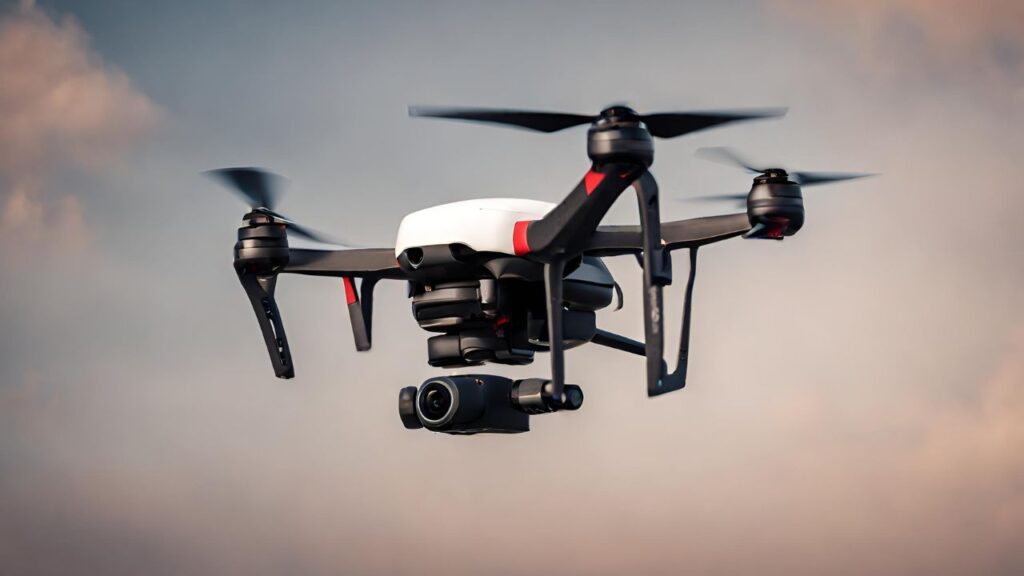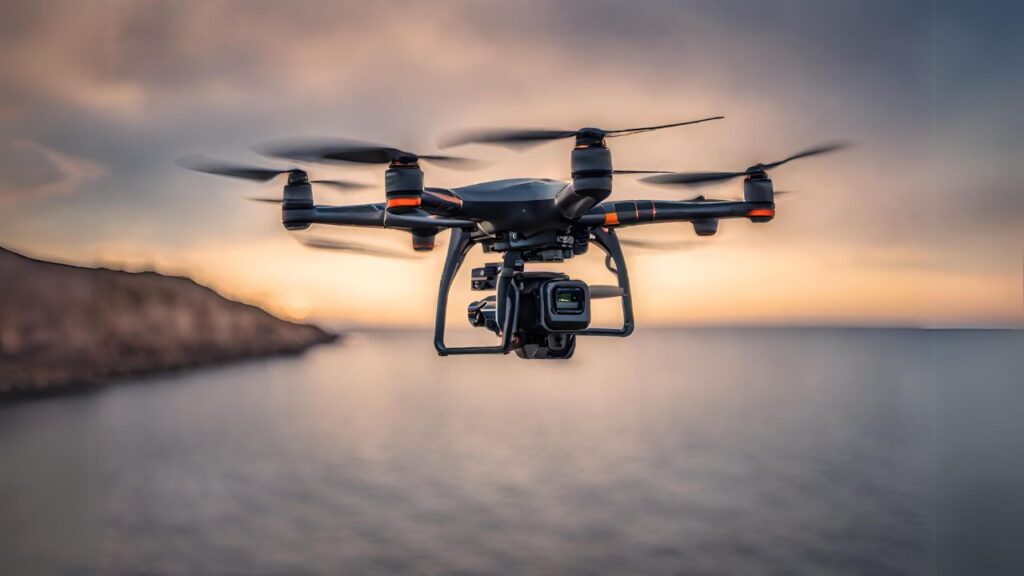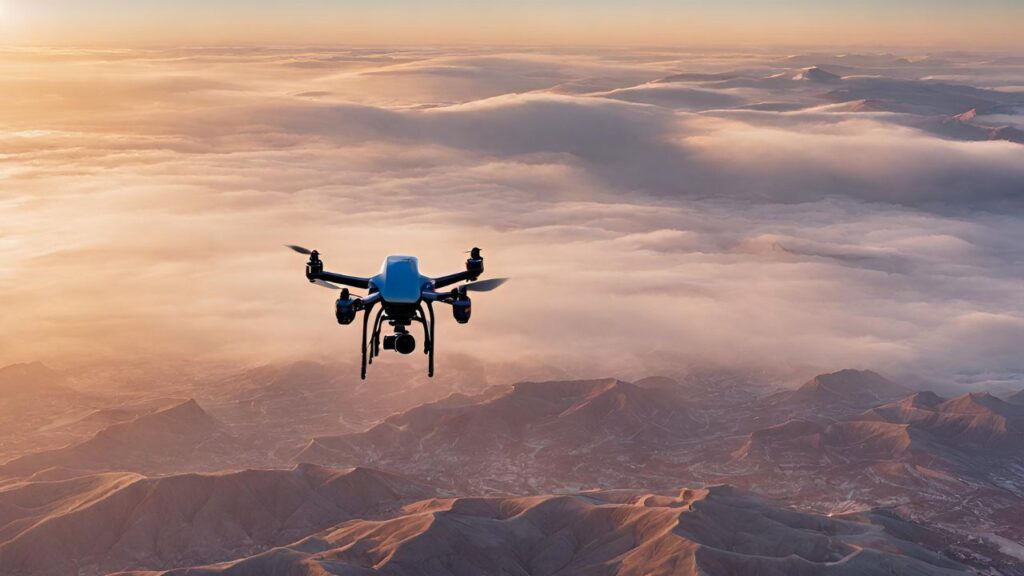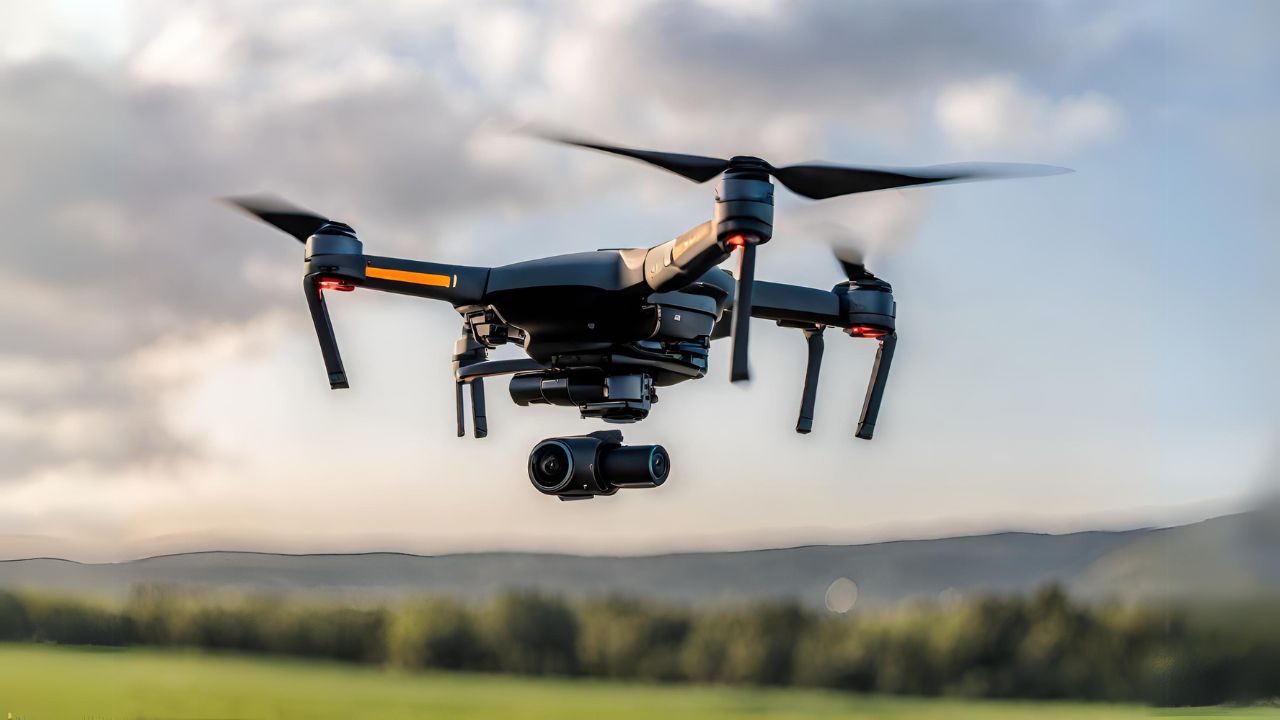In the ever-expanding realm of unmanned aerial vehicles, the question persists: How far can a drone fly? This inquiry delves into the intricate web of factors influencing drone range, from the fundamental characteristics of size, weight, and design, to the regulatory frameworks dictating legal limits. As technology propels drones into new frontiers, the distinctions between mid-range and long-range capabilities, fixed wing and multirotor designs, and consumer and specialized applications become increasingly nuanced. In this comprehensive exploration, we navigate through the landscape of autonomy and flight controls, practical tips for extending flight distances, and real-world examples showcasing the diverse applications of drone technology. From the skies above recreational landscapes to the strategic domains of military and police operations, understanding the nuances of drone flight range unveils a tapestry of possibilities and challenges at the forefront of modern aviation.
Understanding Drone Range: Factors and Influences
Drones, also known as Unmanned Aerial Vehicles (UAVs), come in various shapes and sizes, each designed for specific purposes. Understanding the factors that influence a drone’s range is crucial for both recreational and professional drone pilots.
Size, Weight, and Drone Design:
The physical characteristics of a drone play a significant role in determining its flight range. Generally, smaller and lighter drones have shorter ranges compared to larger ones. This is because smaller drones usually come equipped with smaller batteries, limiting the amount of energy available for flight. Additionally, the design of the drone, including its aerodynamics, can impact how efficiently it uses power to stay airborne.
Battery Types and Capacities:
The type and capacity of a drone’s battery are critical factors influencing its flight range. Lithium-polymer (LiPo) batteries are commonly used in drones due to their high energy density. However, even among LiPo batteries, capacities can vary. Drones with higher-capacity batteries can generally fly longer distances before requiring a recharge. Battery technology advancements are continuously pushing the boundaries, allowing for longer flight times and increased range.
Communication Systems:
The communication system between the drone and its controller is essential for maintaining control and receiving telemetry data. Drones use radio frequencies to communicate with their controllers. The strength and reliability of this communication link can affect the range. Interference from other electronic devices or physical obstacles can disrupt the signal, limiting the drone’s effective range. Advanced communication systems, such as frequency-hopping spread spectrum (FHSS), are employed in high-end drones to enhance signal stability and extend range.
Environmental Factors: Flight Conditions, Climate, and Wind:
The environment in which a drone operates has a direct impact on its range. Flight conditions, such as air density and temperature, can affect the drone’s lift and propulsion efficiency. Drones may experience reduced range at higher altitudes where the air is thinner. Wind speed and direction are crucial considerations as well. Headwinds can decrease a drone’s groundspeed, affecting the time and distance it can cover. Pilots must be aware of these environmental factors to make informed decisions about flight distances and routes.
Types of Drones and Their Range

Drones come in various types, each tailored to specific applications, and their flight ranges can differ significantly based on their design and intended use.
Mid-Range Drone Distance Coverage:
Mid-range drones are commonly used for recreational purposes, aerial photography, and short-distance inspections. These drones typically have a flight range of a few hundred meters to a few kilometers. They are equipped with cameras capable of capturing high-quality images and videos, making them popular among hobbyists and photographers. The limited range is often sufficient for these purposes, and mid-range drones are generally more affordable and easier to operate for casual users.
Long-Range Drones and Applications:
Long-range drones are engineered for more specialized and professional applications. These drones are designed to cover extensive distances and stay airborne for extended periods. Industries such as agriculture, construction, and surveying often use long-range drones for large-scale inspections and data collection. Some long-range drones can cover distances exceeding tens of kilometers, providing a level of versatility that is essential for certain commercial applications.
Fixed Wing vs. Multirotor Drones: Flight Distance Comparison:
The choice between fixed wing and multirotor drones also plays a crucial role in determining the flight range. Fixed wing drones, resembling miniature airplanes, are known for their efficiency in covering long distances. They can stay airborne for extended periods due to their aerodynamic design, making them ideal for applications requiring vast area coverage. Multirotor drones, with their hovering capabilities, are more suited for tasks that involve precise positioning and shorter distances. While fixed wing drones excel in range, multirotor drones offer versatility in maneuverability.
Regulations and Legal Considerations
As the popularity of drones continues to soar, regulatory bodies worldwide have implemented guidelines and laws to ensure safe and responsible drone operations. Understanding the legal limitations is crucial for drone pilots to avoid penalties and maintain a safe airspace environment.
Legal Limits on Drone Flight Distance:
Different countries have varying regulations regarding the maximum allowable flight distance for drones. These regulations are often defined by aviation authorities to prevent interference with manned aircraft, protect privacy, and ensure public safety. For instance, in the United States, the Federal Aviation Administration (FAA) establishes guidelines for drone operations, including restrictions on flying beyond visual line of sight (BVLOS) and specific altitude limits.
EU Safety Protocols for Drones:
In the European Union, the European Union Aviation Safety Agency (EASA) has implemented regulations to standardize drone operations across member states. These regulations include maximum altitude limits, no-fly zones, and requirements for remote identification. Adhering to these protocols is essential for drone pilots operating within the EU to avoid legal consequences and promote overall safety in the airspace.
Drone Autonomy and Flight Controls

Drone autonomy and the capabilities of flight controls are pivotal aspects influencing the effective range and safety of drone operations. Both manual control and autonomous features contribute to the overall performance and reliability of a drone during flight.
Autonomy Impact on Flight Distance:
Drone autonomy refers to the ability of a drone to operate without constant manual input from the pilot. Advanced drones often come equipped with autonomous features such as waypoint navigation, obstacle avoidance, and return-to-home functions. These features can significantly impact the drone’s range by allowing it to navigate predefined routes, avoid obstacles, and safely return to its launch point. Autonomy enhances both the safety and efficiency of drone operations, especially in complex environments.
Controller Range and Aerial Distance:
The range of the drone controller is a critical factor in determining how far a drone can be flown from the pilot’s location. The controller communicates with the drone through radio signals, and the effective range depends on the controller’s technology and the frequency used. Modern controllers can provide ranges ranging from a few hundred meters to several kilometers, allowing pilots to maintain control over their drones within a specified distance. Understanding and respecting the controller range is essential to prevent signal loss and maintain safe and legal drone operations.
Line of Vision Restrictions:
Maintaining visual contact with the drone, known as visual line of sight (VLOS), is a regulatory requirement in many regions. Even with autonomous features, regulations often mandate that pilots keep the drone within their direct line of sight. This requirement ensures that pilots can quickly assess the surroundings, avoid obstacles, and respond to unexpected situations. Understanding and adhering to VLOS regulations is crucial for safe and responsible drone flying.
What Happens When a Drone Exceeds Its Range?
Despite the advancements in drone technology, instances can occur where a drone surpasses its designated range. Understanding the potential outcomes and safety measures in such situations is crucial for preventing accidents and damage.
Autonomously Return to Base:
Many modern drones are equipped with failsafe mechanisms that trigger an automatic return-to-home (RTH) feature when the drone exceeds its communication range or encounters low battery levels. The drone, utilizing GPS and other sensors, autonomously navigates back to its launch point. This feature helps prevent the drone from becoming uncontrollable and ensures a safe return, especially in scenarios where the pilot loses connection.
Hover and Pause:
Some drones, upon reaching their communication limits, enter a hover-and-pause state. In this mode, the drone hovers in its current position and ceases further movement. This provides an opportunity for the pilot to reestablish communication or take manual control once the drone is within range. It acts as a safety measure to avoid uncontrolled drift or potential collisions.
Emergency Landing Procedures:
In situations where the drone cannot return to its launch point or maintain a stable hover, emergency landing procedures may be initiated. Drones are programmed to execute controlled descents to minimize the risk of damage upon landing. This ensures that even in unexpected circumstances, the drone lands safely without posing a threat to people or property.
Collision Risks:
If a drone surpasses its range without triggering autonomous return or hover-and-pause functions, there is a risk of collisions with obstacles or other aircraft. Understanding the potential consequences of exceeding range limits underscores the importance of responsible and compliant drone operations. Pilots must prioritize safety and follow operational guidelines to mitigate risks associated with out-of-range scenarios.
Enhancing Drone Range

While drones are equipped with predefined capabilities, there are ways for pilots to enhance their drone’s range through software, hardware, and additional accessories. These enhancements can empower pilots to extend flight distances and optimize their drone’s performance.
Software Recommendations:
Upgrading drone software can unlock additional features and improvements, potentially enhancing the overall performance and range. Manufacturers often release firmware updates that address bugs, optimize power consumption, and improve communication protocols. Staying informed about software updates and regularly updating the drone’s firmware ensures access to the latest enhancements.
Hardware Upgrades:
Some drones allow hardware upgrades, such as installing higher-capacity batteries or more efficient propellers. Upgrading to a battery with a larger capacity can extend flight times and increase the potential range. However, it’s crucial to ensure that any hardware modifications are compatible with the drone’s design and do not compromise its safety or stability.
Range Extension Devices:
External devices designed to extend the drone’s communication range can be valuable additions for pilots seeking to cover longer distances. Range extenders and signal boosters amplify the controller’s signal, allowing the drone to maintain a stable connection over greater distances. Pilots should choose these devices carefully, ensuring compatibility with their specific drone model and complying with local regulations.
Practical Tips for Extending Drone Flight Distance
In addition to software, hardware, and accessory enhancements, there are practical measures that drone pilots can take to maximize their drone’s flight distance. These tips focus on maintenance, planning, and environmental considerations to ensure safe and efficient operations.
Maintenance Steps for Maximum Range:
Regular maintenance is essential for optimal drone performance and extended flight distances. Keep the drone clean and inspect components for any signs of wear or damage. Ensure that propellers are balanced, motors are functioning correctly, and the drone’s firmware is up to date. Proper maintenance not only enhances reliability but also contributes to efficient power usage, extending overall flight times.
Additional Considerations for Drone Flight Range:
- Temperature Management: Extreme temperatures can impact battery performance. Flying in moderate temperatures helps maintain battery efficiency and extends the drone’s range.
- Payload Optimization: Minimize unnecessary payload to reduce the drone’s weight, enhancing its efficiency and extending flight distances.
- Flight Path Planning: Plan efficient flight paths to minimize unnecessary maneuvers and optimize battery usage. Consider wind direction to leverage tailwinds for improved efficiency.
- Altitude Control: Avoid flying at excessively high altitudes, as thinner air can reduce the drone’s efficiency. Understanding the drone’s operating limits in different altitudes is crucial for maximizing range.
- Signal Interference Avoidance: Choose locations with minimal signal interference to ensure a stable communication link between the drone and its controller. Avoid flying near electromagnetic sources or areas with heavy radio frequency traffic.
Case Examples: How Far Can a Drones Fly?
Examining real-world examples provides valuable insights into the capabilities of different drones and the factors influencing their flight distances. These cases showcase the diversity of drone applications and the technological advancements that continue to shape the industry.
Real-world Examples of Drone Flight Distances:
- Consumer Drones: Popular consumer drones, such as the DJI Mavic series, typically have a range of several kilometers, allowing users to capture stunning aerial footage and explore landscapes. These drones strike a balance between portability, features, and flight distance, catering to recreational users and amateur photographers.
- Commercial and Industrial Drones: Drones designed for commercial and industrial applications often boast longer flight ranges. For example, the senseFly eBee X, used in mapping and surveying, can cover large areas, reaching distances of over 10 kilometers. These drones prioritize endurance and efficiency to meet the demands of professional users.
- Fixed Wing Drones: Fixed wing drones, like the Parrot Disco, are known for their extended flight distances. Capable of covering tens of kilometers in a single flight, these drones excel in applications requiring vast area coverage, such as agriculture and environmental monitoring.
Maximum Height and Distance Limits in Different Regions:
Different regions and countries may impose specific limits on the maximum altitude and distance drones can fly. For instance, in the United States, the FAA imposes a maximum altitude of 400 feet above ground level for recreational drones. Understanding and adhering to these regional restrictions is crucial for responsible and legal drone operations.
Military and Police Drone Capabilities
Military and police drones represent a category of unmanned aerial vehicles with unique capabilities tailored for specific operational requirements. Understanding the capabilities and limitations of these drones provides insights into their role in surveillance, reconnaissance, and law enforcement.
Maximum Range for Military Drones:
Military drones, also known as Unmanned Combat Aerial Vehicles (UCAVs) or Unmanned Aerial Systems (UAS), often have significantly longer ranges compared to consumer and commercial drones. Some military drones can operate at ranges exceeding thousands of kilometers. These drones are designed for long-endurance missions, allowing for extended surveillance, reconnaissance, and, in some cases, offensive capabilities.
Police Drone Flight Distance Limits:
Police drones, used for surveillance, search and rescue, and monitoring public events, typically have more moderate flight distances compared to military counterparts. However, these drones still provide valuable capabilities for law enforcement agencies. The range of police drones can vary based on their intended use, with some models capable of covering several kilometers.
Operational Considerations for Military and Police Drones:
- Mission Duration: Military drones are designed for extended missions, sometimes lasting more than 24 hours. This allows for continuous monitoring and intelligence gathering. Police drones, while not requiring such extended durations, still benefit from longer flight times for efficient operations.
- Real-time Surveillance: Both military and police drones often feature real-time surveillance capabilities, providing live video feeds to operators on the ground. This feature enhances situational awareness and decision-making during operations.
- Precision and Maneuverability: Military drones are often equipped with advanced navigation and targeting systems for precision strikes. Police drones prioritize maneuverability and stability for effective surveillance and response in various urban and suburban environments.
Conclusion
In conclusion, the range of a drone is a multifaceted aspect influenced by factors ranging from the drone’s size, weight, and design to the regulatory landscape governing its operation. As drone technology continues to advance, the distinctions between mid-range and long-range drones, fixed wing and multirotor designs, and consumer and specialized applications become more pronounced. Legal considerations and safety protocols add a layer of responsibility for drone pilots, emphasizing the need to stay informed about regional regulations. The interplay of autonomy and flight controls underscores the delicate balance between manual oversight and automated features. Additionally, practical tips for extending drone flight distance, along with case examples showcasing real-world applications, offer a comprehensive perspective. From military to police drones, different sectors leverage unmanned aerial vehicles for varied purposes, each tailored to meet specific operational requirements. As the drone industry evolves, so too will the possibilities for flight distances, creating new opportunities and challenges for enthusiasts, professionals, and regulatory bodies alike.

